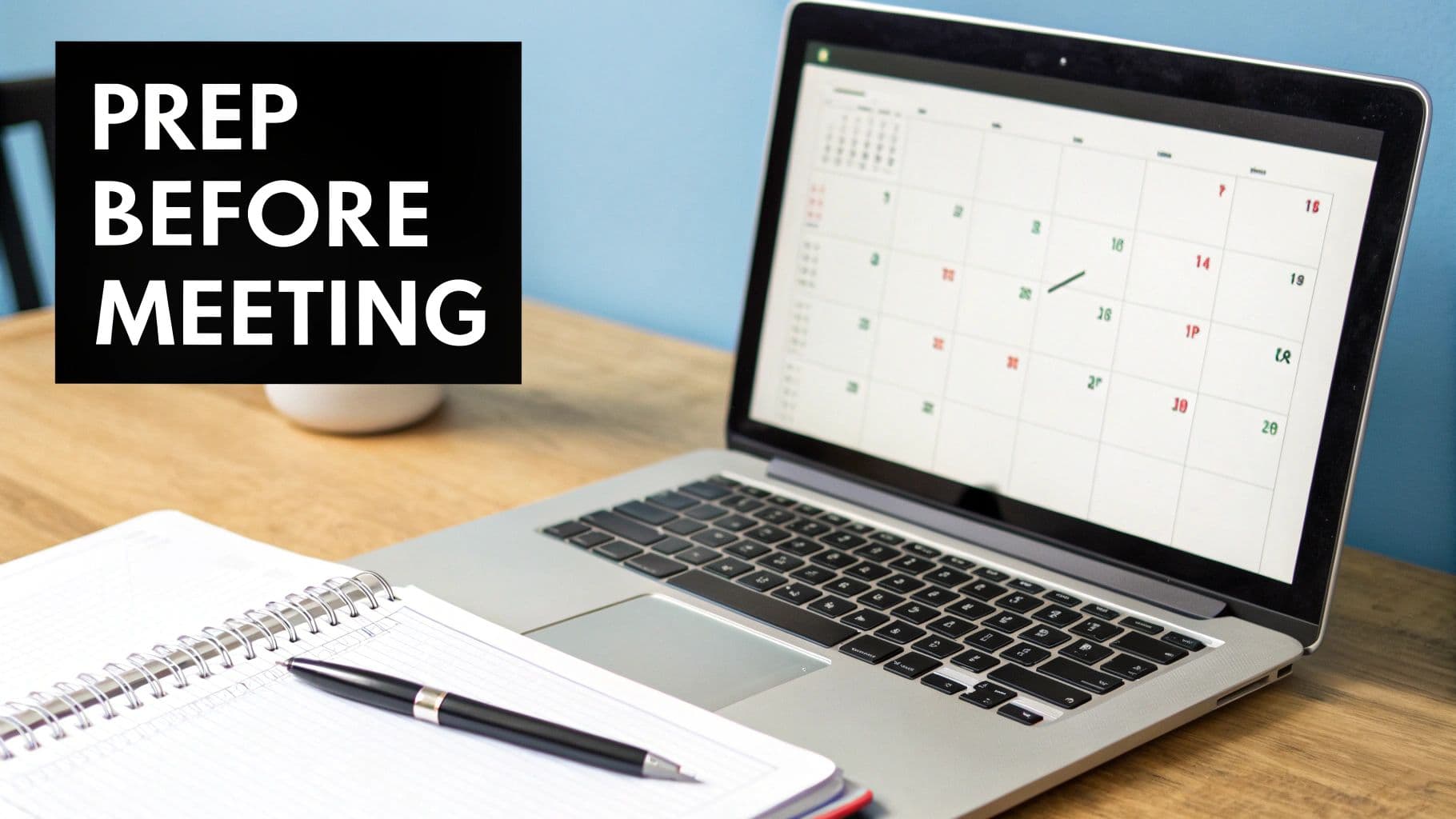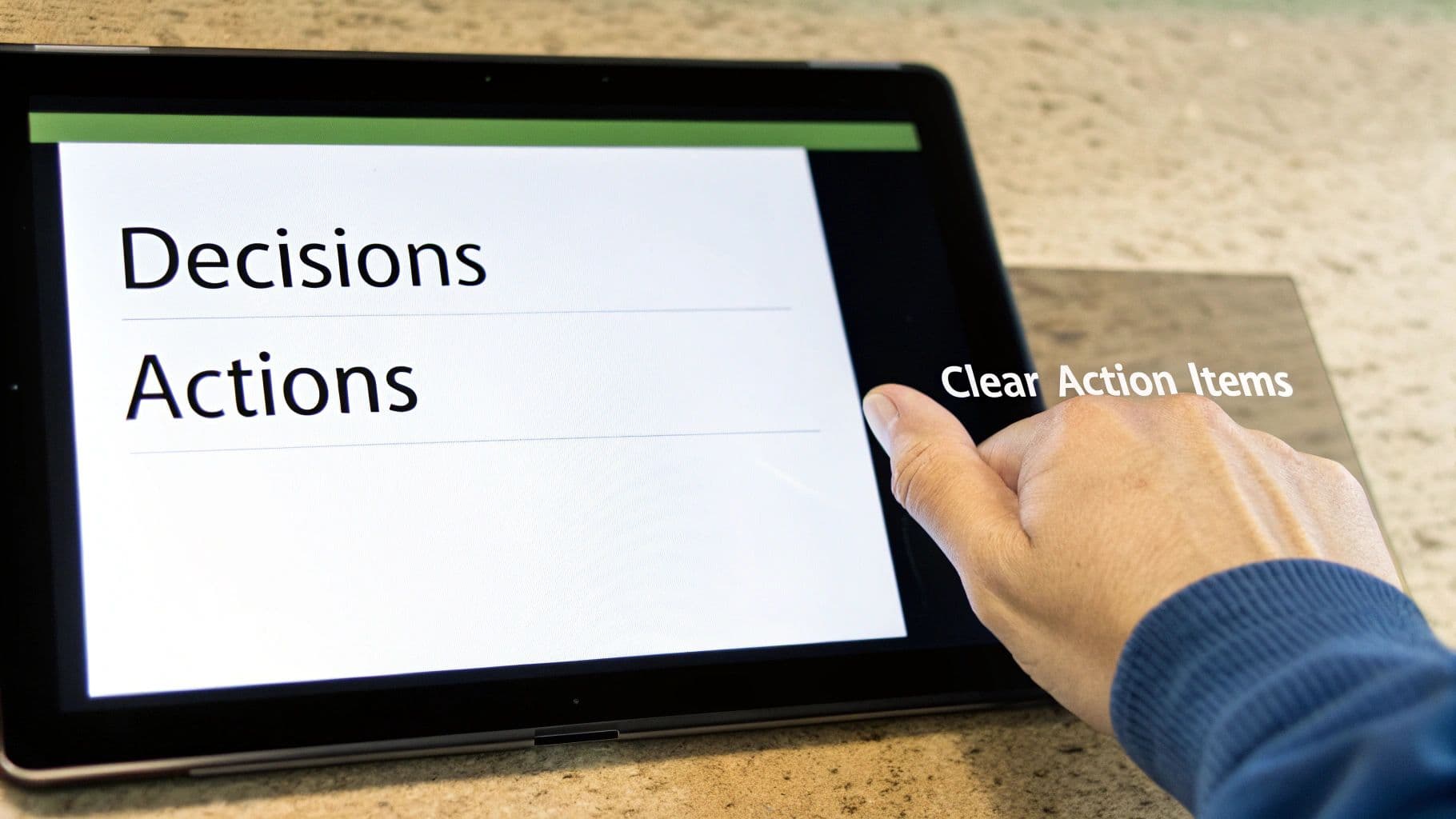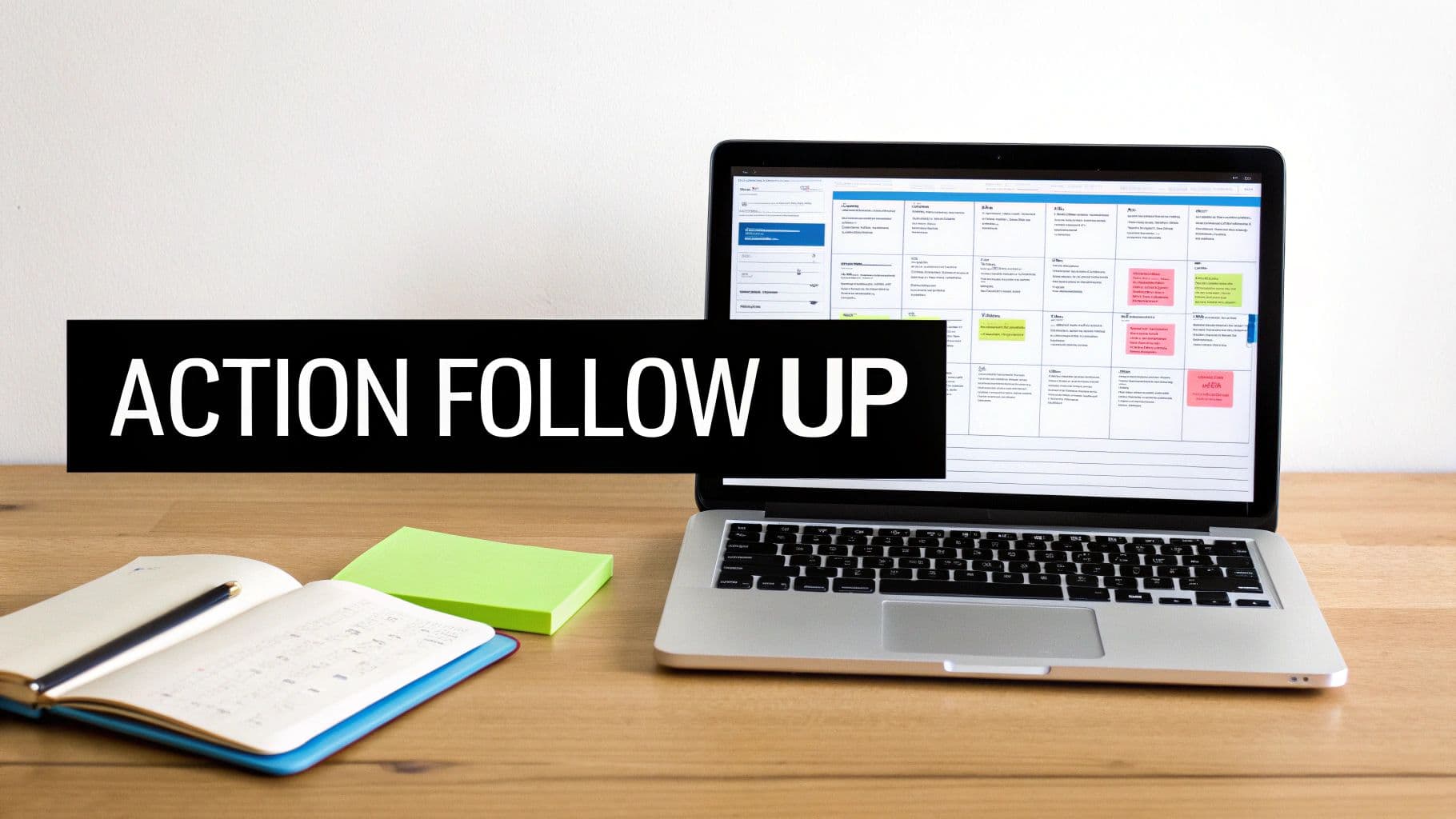Let's be real—taking meeting notes is one thing, but organizing them is where the real magic happens. It’s the process of turning a jumble of thoughts and comments into a clear, actionable record.
When you get it right, you create a system where decisions, key insights, and action items are easy to find, share, and act on. This simple shift can transform a tedious task into a massive productivity booster, keeping everyone aligned long after the meeting wraps up.
Why Organized Meeting Notes Actually Matter

We've all been there. The notes from last week's "critical" meeting are buried in a random document, a private notebook, or worse, completely forgotten. This digital graveyard of good intentions isn't just a minor inconvenience; it has real consequences.
Missed deadlines, conversations that go in circles, and a fuzzy sense of who's responsible for what—these issues often trace back to messy or inaccessible notes. For remote and hybrid teams, having a clear, central record isn't just nice to have; it's the lifeline that keeps everyone on the same page, no matter where they are.
The True Cost of Disorganization
When notes are a mess, teams bleed time and energy. Think about it: employees around the world spend an average of 11.3 hours per week in meetings, and a staggering 35% of that time is often seen as a waste. According to research from Flowtrace on meeting effectiveness, this is usually due to poor planning and unclear outcomes.
That’s where a structured approach to note-taking comes in. It’s not just about administrative busywork; it's a high-impact skill that makes every minute in that meeting count.
Ultimately, learning how to organize meeting notes is about turning a simple habit into a powerful tool that drives your projects forward.
Prepare Your Notes Before the Meeting Starts

The secret to great meeting notes has almost nothing to do with what happens during the meeting. It’s all about the prep work you do before it even starts.
Walking into a discussion cold is a recipe for disorganized, chaotic notes. But if you take just a few minutes beforehand, you can turn a basic agenda into a powerful framework that guides your note-taking. This simple habit is the single biggest difference between capturing random chatter and creating a valuable record.
It’s a surprisingly uncommon practice. Research shows that only 37% of workplace meetings actually use a set agenda, which is wild when you think about it. Without that structure, notes become a jumbled mess that doesn't capture what truly matters. If you want to dive deeper, you can explore more meeting statistics to see how preparation impacts productivity.
Turn the Agenda Into Your Note-Taking Blueprint
This is where the magic happens. Before the meeting kicks off, grab the agenda and use its main points as headings in your notes document. Just copy and paste them, leaving space under each one. Now you have a ready-made structure to slot in discussions, decisions, and action items as they come up.
Let's say you're prepping for a project kickoff meeting. Your agenda-turned-template might look something like this:
- Project Goals & Success Metrics: What are we trying to achieve?
- Key Deliverables & Timeline: What's the output and when is it due?
- Team Roles & Responsibilities: Who is doing what?
- Known Risks & Blockers: What could stop us?
By doing this, you're not just passively listening; you're actively organizing information as the conversation flows.
Get Your Tools Ready
Whether you're a fan of digital tools like Notion or a shared Google Doc, or you prefer a classic pen and notebook, get it set up beforehand. Create a new document, pop in the meeting title, date, and a list of who’s attending. Then, drop in your new agenda-based template.
A little prep goes a long way. You'll walk in ready to capture insights from the get-go instead of scrambling to catch up.
To make this even easier, I've put together a quick checklist you can run through before your next call.
Your Pre-Meeting Note Preparation Checklist
Use this simple checklist before every meeting to ensure your note-taking is structured and effective from the start.
Following these steps takes maybe five minutes, but the payoff in clarity and organization is huge. You'll feel more in control and your notes will be infinitely more useful.
Capture Notes That Everyone Can Understand

Once the meeting gets going, that template you prepared earlier is going to be your lifeline. The biggest mistake I see people make is trying to write down every single word. This just creates a massive wall of text that's a nightmare to sort through later.
Forget being a court reporter; think of yourself as a curator. Your job is to pull out the essential stuff: the final decisions, the lightbulb moments, and the action items that will actually move the project forward. This is the real secret to organizing meeting notes that people will actually use.
Separate Signals From Noise
To keep your notes from becoming a jumbled mess, you have to break things down into categories. This simple habit makes your notes a hundred times more valuable, especially for anyone who missed the meeting.
I always start with these three main buckets:
- Key Decisions: This is for the final verdict. What did the team agree to do? Write it down as a clear, simple statement so there’s no confusion.
- Important Insights: Here’s where you capture those "aha!" moments, surprising stats, or strong opinions that shaped the decisions. It adds the "why" behind the "what."
- Action Items: This is non-negotiable and easily the most important part. List every task, who's responsible, and the deadline.
Sorting your notes this way tells a clear story. It takes the reader from the big ideas down to the specific to-dos. If you want to dig deeper, our guide on meeting minutes best practices has some great tips for creating flawless records.
Define Action Items With The WWW Model
Vague action items are a project's worst enemy. "Look into the marketing budget" is a dead-end task. A much better approach is the Who, What, By When (WWW) model. It creates airtight tasks that leave zero room for guessing.
Here’s the breakdown:
- Who: Assign the task to one person. Accountability gets lost the second you assign a task to a group.
- What: Be specific. Start with an action verb that clearly defines the work.
- By When: Give it a firm deadline. "Next week" is okay, but "Friday, October 25th" is way better.
This simple structure makes your notes powerful. To make sure you’re always creating clear and useful notes, it’s worth mastering the fundamentals of how to take better meeting notes that drive action. When you nail this, your notes stop being just a record of what happened and become a genuine project management tool.
Use Modern Tools to Streamline Your Workflow
Let's be honest, technology can be a massive help for organizing meeting notes, but only if it actually fits how you work. The wrong tool just adds another layer of complexity. The right one automates the grunt work, so you can stop typing and start paying attention to the conversation.
Collaborative platforms like Notion are a fantastic place to start. I've seen teams build incredible systems where they can link meeting decisions directly to project briefs and action items, all within one shared workspace.
What I love about this approach is that it creates a single source of truth. No more digging through emails, Slack threads, and random documents to find what was decided last Tuesday.
Let AI Do the Heavy Lifting
Artificial intelligence is really changing the game here. AI-powered tools can listen in, transcribe the conversation in real-time, figure out who said what, and then spit out a surprisingly good summary of the important points. You get a perfect record of the meeting without having to furiously type the whole time.
This isn't just a niche trend; it's a major shift. By 2025, 14% of professional meeting planners will see AI as essential for running meetings, a huge jump from just 4% in 2024. That tells you where things are headed.
If you want to get your discussions organized, using a specialized meeting notes tool is a great move. For teams ready to take it to the next level, checking out the best AI meeting assistant tools of 2025 can show you just how much of your workflow—from transcription to task assignment—can be automated.
Turn Your Notes Into Action After the Meeting

The real value of a meeting isn't what happens in the room—it's what happens after. This is the moment your well-organized notes stop being just a record and start driving real progress.
The key is to move fast. Don't let your notes get stale. The best time to clean them up is within a few hours of the meeting, while the conversations and context are still fresh. I call this the "golden window." Use it to polish your phrasing, clarify any ambiguous points, and pull out the most important takeaways before you get pulled into your next task.
Distribute and Assign Action Items
With your notes cleaned up, it's time to extract the action items. Simply emailing a summary and hoping people follow through is a recipe for inaction. True accountability needs clarity.
Go through your notes and pull out every single task you recorded using the "Who, What, By When" method. Then, plug those tasks directly into whatever project management tool your team uses, like Asana or Jira. If you don't use a formal tool, a shared spreadsheet works just as well.
Assign each task to the owner with the deadline you all agreed on.
If you want to really nail this part of the process, this guide on a meeting action items template that actually works is a great resource.
Finally, make sure the finished notes are stored somewhere everyone can find them. A shared drive, a dedicated Slack channel, or a folder in your team's wiki are all great options. Creating this central, searchable archive means your team won't have to waste time rehashing the same conversations again.
Still Have Questions About Organizing Meeting Notes?
Even with a solid system in place, some common questions always seem to pop up. Let's tackle a few of the most frequent ones I hear. Getting these sorted will help you build a note-taking process that truly works for your team.
What's the Best Way to Format Meeting Notes?
There’s no single "best" way, but I’ve found that a simple, outcome-focused structure is what makes notes genuinely useful. Forget trying to write down every single word. Instead, break your notes down into clear, scannable sections.
This is the framework I always come back to:
- Key Decisions: What did we actually agree on? Be specific.
- Action Items: Who is doing what? And what’s the deadline?
- Open Questions: What loose ends do we still need to tie up?
This simple approach turns a messy stream of consciousness into something anyone can understand at a glance.
How Fast Should I Send Out the Notes?
Get them out quickly. My rule of thumb is to clean up, summarize, and share the notes within a few hours, and never later than 24 hours after the meeting wraps.
Think of it as a "golden window." If you wait any longer, memories start to get fuzzy, the energy from the conversation disappears, and those important action items start to feel less urgent. Sharing them promptly keeps everyone on the same page and maintains momentum.
Shouldn't I Just Record the Meeting and Be Done With It?
While recording a meeting is a great idea for a backup, it's a terrible substitute for taking good notes. Let's be real—nobody wants to scrub through a 60-minute video to find that one decision that was made around the 42-minute mark.
Your written notes are the executive summary. They pull out the most critical information—the decisions, the tasks, the deadlines. The recording is just the raw footage you can reference if there's ever a dispute or a need to clarify a nuanced point. The best of both worlds is having structured notes with a recording on hand just in case.
Finding the right tool to help capture and summarize everything can be a game-changer. At Summarize Meeting, we’ve put together a detailed guide to help you compare the best AI meeting summarization tools out there, so you can find the perfect fit for you and your team.